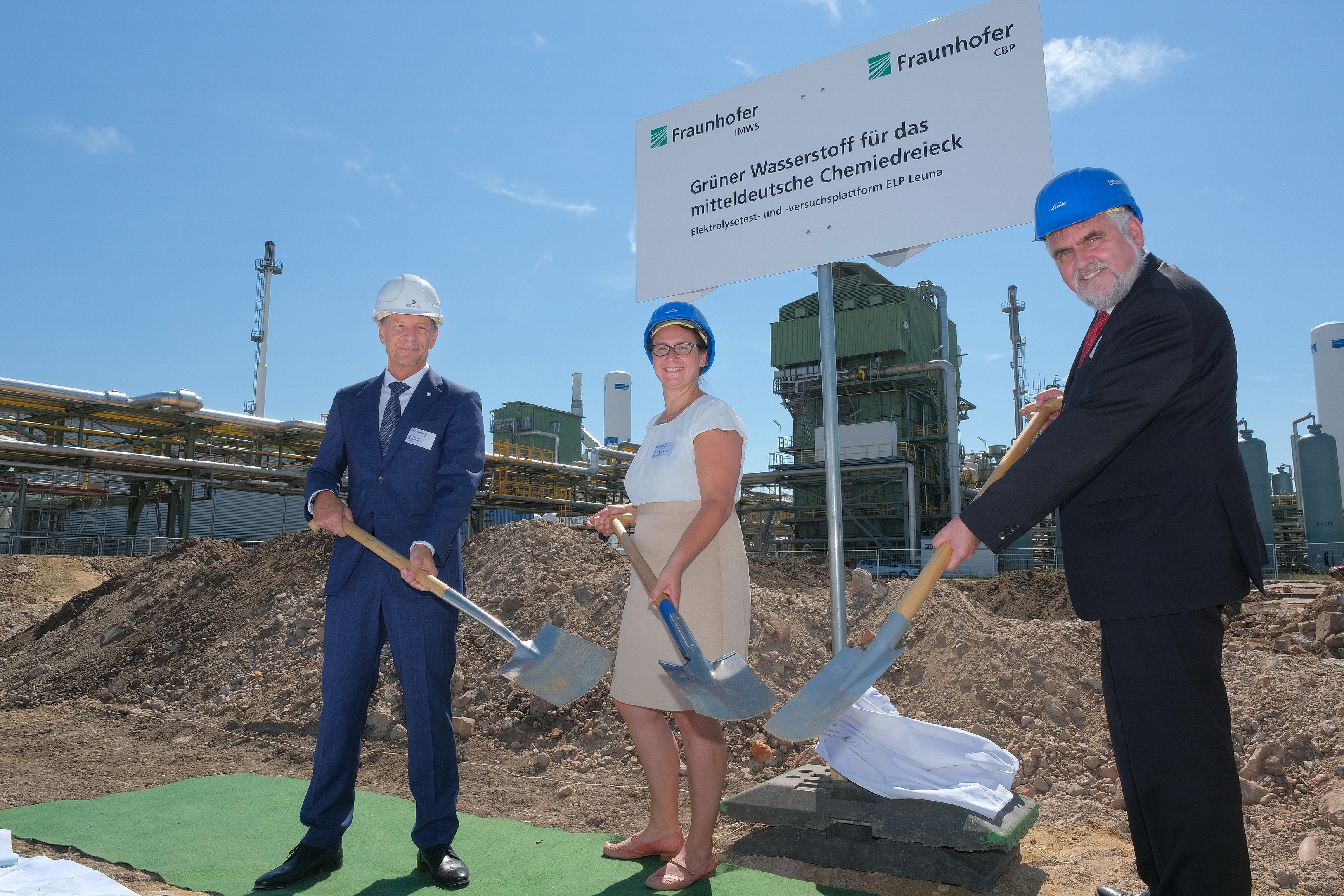»Green« hydrogen as a catalyst for sustainable chemical industry
Hydrogen is the key element to establish a sustainable chemical industry. With the Hydrogen Lab in Leuna (HLL), subject to today’s festive groundbreaking ceremony, the Free State of Saxony-Anhalt assumes a pioneering role in achieving these goals. The pilot system will produce green hydrogen for the production of basic chemicals and fuels with low emissions as the Fraunhofer Center for Chemical-Biotechnological Processes (CBP) in Leuna and the Fraunhofer Institute for Microstructure of Materials and Systems (IMWS) in Halle (Saale) bring together their expertise.


At present, hydrogen is one of the most important raw materials for more than 600 companies forming the so-called “chemical triangle” in central Germany. Until now, hydrogen has been produced from fossil raw materials with correspondingly high rates of CO2 emissions. The approach used by the new pilot system relies on sustainable resources: Electricity from photovoltaic or wind turbine systems is used to produce hydrogen from water by means of the electrolysis technique. This green hydrogen is climate-neutral and made available to the companies located here through the materials network for the chemical industry park.
»Saxony-Anhalt provides ideal local conditions for this«, Professor Armin Willingmann, Minister for Economy, Science and Digitalization of the Free State, says of the groundbreaking for the pilot system. »Here, electricity is produced in enormous quantities from renewable energy sources, and, at the same time, the chemical companies here have a huge demand for hydrogen; on the top of this, we have an existing pipeline system and storage capacities. We targeted this industry early on and are, consequently, now in an excellent starting position to verify its potential for the economy in the region.«
The Fraunhofer Hydrogen Lab Leuna (HLL) includes laboratories, offices, and a pilot plant; it is used to try out and assess the operation and functionality of different electrolysis systems on an industrial scale. In the outdoor area, test areas are available for modular use for power-to-X- and power-to-liquid projects up to 5 MW connected power. Subjects of research include interaction with a fluctuating power supply from renewable energy sources under real operational conditions, the enhancement of materials in use, and optimal infeed into the existing gas pipeline, as well as the development of suitable business models.
Dr.-Ing. Sylvia Schattauer, who, as the Deputy Head of the Institute, is responsible for activities related to hydrogen and carbon at the Fraunhofer IMWS, highlights the opportunities that could arise from the pilot system even for small- and medium-sized companies: » Fraunhofer is supporting the establishment of hydrogen-based industry in Germany with a multitude of activities. If we courageously seize our opportunities in this emerging market, then we can strengthen competitiveness and the power of innovation and develop a model region for a sustainable industrialized society. This is an important contribution to making structural changes and climate protection successful at the same time.«
The Hydrogen Lab Leuna (HLL) is employed to obtain data immediately from the application, making it possible to optimize the operation. In associated projects, the researchers further develop techniques to produce synthesis gas by means of co-electrolysis of water and carbon dioxide. As a result, not only green hydrogen, but also basic chemicals and sustainable synthetic fuels can be produced in Leuna.
The Fraunhofer Center for Chemical-Biotechnological Processes (CBP) contributes important expertise in chemical process engineering. »If we, in addition to other regenerative raw materials, also invest in green hydrogen as a raw material and further refine the synthesis processes, then this will substantially contribute to a sustainable chemical industry. With the platform emerging now, we wish to demonstrate the technical-economic relevance of systems like these and pave the way for large-scale production of green hydrogen to be feasible for the market«, says Dr. Markus Wolperdinger, Head of the Fraunhofer Institute for Interfacial Engineering and Biotechnology (IGB), of which the Fraunhofer CBP is a part. The first projects will begin in 2021.
Here you can watch the image film "Germany's Next Generation Energy Hubs", in which the Fraunhofer IMWS was involved.